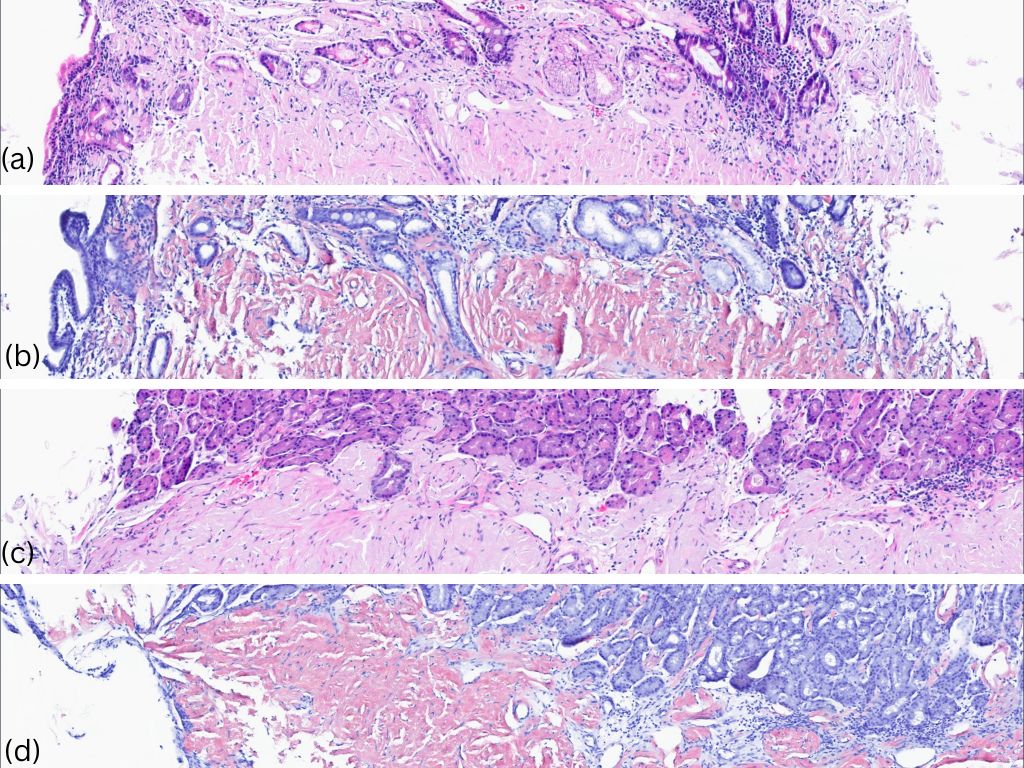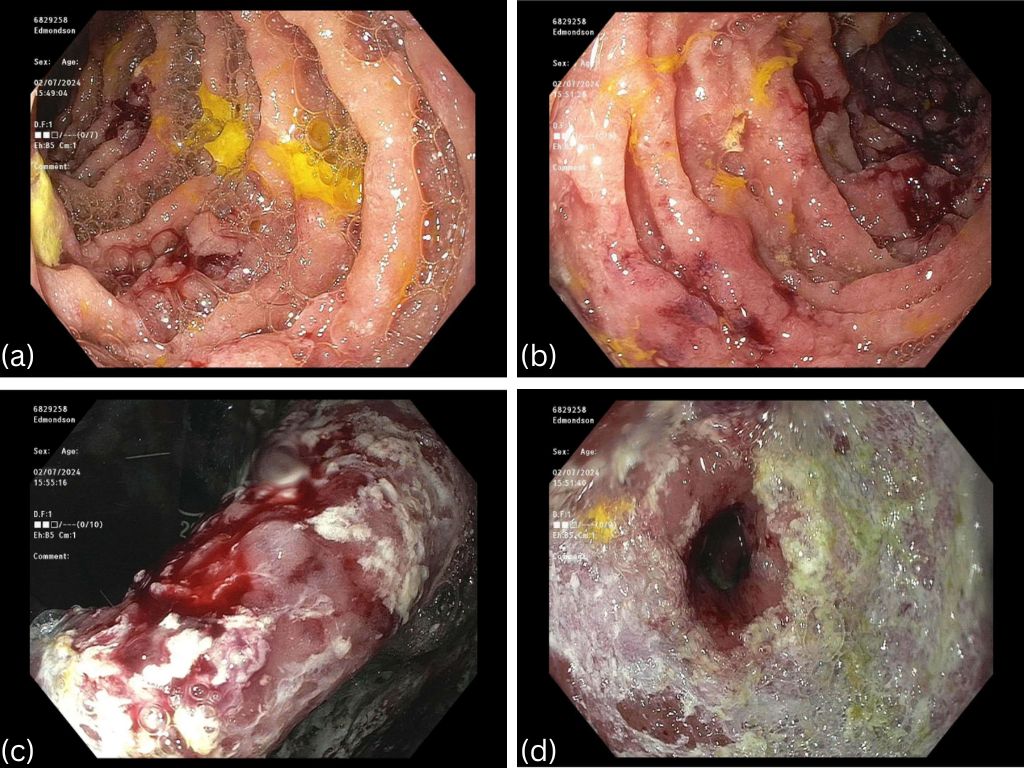Tuesday Poster Session
Category: General Endoscopy
P5161 - Gastrointestinal Manifestations of Systemic AL Amyloidosis
Tuesday, October 28, 2025
10:30 AM - 4:00 PM PDT
Location: Exhibit Hall
- KR
Keerthi Reddy, MD
Emory University
Atlanta, GA
Presenting Author(s)
Keerthi Reddy, MD, Aaron Hein, MD, Julia Massaad, MD
Emory University, Atlanta, GA
Introduction: Systemic amyloidosis is the extracellular deposition of abnormal proteins in various organs. Manifestations of gastrointestinal amyloidosis (GIA) include bleeding, pain, nausea, vomiting, or obstruction. GIA has a variety of endoscopic findings and may appear normal endoscopically. Given the non-specific nature of the symptoms and endoscopic appearance, diagnosing GIA can be challenging. We present a patient with GI manifestations of systemic AL amyloidosis.
Case Description/
Methods: A 70-year-old male with a recent diagnosis of non-ischemic heart failure initially presented for 3 months of nausea, vomiting, and epigastric pain. He was transferred after developing ventricular tachycardia and acute kidney injury (AKI). He underwent 2 upper endoscopies (EGD) 1 week apart at the outside facility, revealing progression of gastritis and duodenitis with severe pyloric stenosis on the second EGD. Biopsy revealed inflammation, but Congo red staining was not performed. EGD at our facility 1 week later showed thickened erythematous folds in the stomach and duodenum with rapidly progressive friability and erosions. In conjunction with a kappa/lambda ratio of 142, AKI, and newly diagnosed heart failure, a systemic infiltrative process was considered. He underwent endomyocardial biopsy, and both EGD and endomyocardial biopsies revealed amyloidosis. Bone marrow biopsy confirmed plasma cell neoplasm. Course was complicated by refractory ventricular arrhythmias resulting in cardiac arrest and comfort care.
Discussion: GIA can represent a diagnostic dilemma due to a non-specific symptom complex, inconsistent endoscopic findings, and lack of a standard classification system. Early symptoms include weight loss, early satiety, nausea, or chronic diarrhea. GIA should remain on the differential in older patients with such symptoms. Further, there is a clear need to develop a classification system for endoscopic findings due to its variable appearance. In 2024, Song et al proposed a classification including 5 main types: protruding, granular, ulcerative, hemorrhagic, or nonspecific. Prospective studies are needed to assess its utility. In these patients, Congo red staining should be performed. Early recognition of symptoms and diagnosis of GIA can aid in the diagnosis of systemic amyloidosis, lead to earlier treatment initiation, and can prevent adverse outcomes.
Song JH, et al. Endoscopic Features of Gastrointestinal Amyloidosis: A Proposed Endoscopic Classification. Gut and Liver (April 2025). eISSN 2005-1212.

Figure: Figure 1: Pathology taken from EGD
(a) Duodenal biopsy H&E
(b) Duodenal biopsy Congo red
(c) Stomach biopsy H&E
(d) Stomach biopsy Congo red

Figure: Figure 2: Endoscopic Images
(a) and (b) Duodenum with thicken erythematous folds, with friability, erosions, and villous blunting
(c) Incisura with thickened erythematous folds
(d) Pylorus with mucosa covered in residue, grossly abnormal appearance
Disclosures:
Keerthi Reddy indicated no relevant financial relationships.
Aaron Hein indicated no relevant financial relationships.
Julia Massaad indicated no relevant financial relationships.
Keerthi Reddy, MD, Aaron Hein, MD, Julia Massaad, MD. P5161 - Gastrointestinal Manifestations of Systemic AL Amyloidosis, ACG 2025 Annual Scientific Meeting Abstracts. Phoenix, AZ: American College of Gastroenterology.
Emory University, Atlanta, GA
Introduction: Systemic amyloidosis is the extracellular deposition of abnormal proteins in various organs. Manifestations of gastrointestinal amyloidosis (GIA) include bleeding, pain, nausea, vomiting, or obstruction. GIA has a variety of endoscopic findings and may appear normal endoscopically. Given the non-specific nature of the symptoms and endoscopic appearance, diagnosing GIA can be challenging. We present a patient with GI manifestations of systemic AL amyloidosis.
Case Description/
Methods: A 70-year-old male with a recent diagnosis of non-ischemic heart failure initially presented for 3 months of nausea, vomiting, and epigastric pain. He was transferred after developing ventricular tachycardia and acute kidney injury (AKI). He underwent 2 upper endoscopies (EGD) 1 week apart at the outside facility, revealing progression of gastritis and duodenitis with severe pyloric stenosis on the second EGD. Biopsy revealed inflammation, but Congo red staining was not performed. EGD at our facility 1 week later showed thickened erythematous folds in the stomach and duodenum with rapidly progressive friability and erosions. In conjunction with a kappa/lambda ratio of 142, AKI, and newly diagnosed heart failure, a systemic infiltrative process was considered. He underwent endomyocardial biopsy, and both EGD and endomyocardial biopsies revealed amyloidosis. Bone marrow biopsy confirmed plasma cell neoplasm. Course was complicated by refractory ventricular arrhythmias resulting in cardiac arrest and comfort care.
Discussion: GIA can represent a diagnostic dilemma due to a non-specific symptom complex, inconsistent endoscopic findings, and lack of a standard classification system. Early symptoms include weight loss, early satiety, nausea, or chronic diarrhea. GIA should remain on the differential in older patients with such symptoms. Further, there is a clear need to develop a classification system for endoscopic findings due to its variable appearance. In 2024, Song et al proposed a classification including 5 main types: protruding, granular, ulcerative, hemorrhagic, or nonspecific. Prospective studies are needed to assess its utility. In these patients, Congo red staining should be performed. Early recognition of symptoms and diagnosis of GIA can aid in the diagnosis of systemic amyloidosis, lead to earlier treatment initiation, and can prevent adverse outcomes.
Song JH, et al. Endoscopic Features of Gastrointestinal Amyloidosis: A Proposed Endoscopic Classification. Gut and Liver (April 2025). eISSN 2005-1212.

Figure: Figure 1: Pathology taken from EGD
(a) Duodenal biopsy H&E
(b) Duodenal biopsy Congo red
(c) Stomach biopsy H&E
(d) Stomach biopsy Congo red

Figure: Figure 2: Endoscopic Images
(a) and (b) Duodenum with thicken erythematous folds, with friability, erosions, and villous blunting
(c) Incisura with thickened erythematous folds
(d) Pylorus with mucosa covered in residue, grossly abnormal appearance
Disclosures:
Keerthi Reddy indicated no relevant financial relationships.
Aaron Hein indicated no relevant financial relationships.
Julia Massaad indicated no relevant financial relationships.
Keerthi Reddy, MD, Aaron Hein, MD, Julia Massaad, MD. P5161 - Gastrointestinal Manifestations of Systemic AL Amyloidosis, ACG 2025 Annual Scientific Meeting Abstracts. Phoenix, AZ: American College of Gastroenterology.

